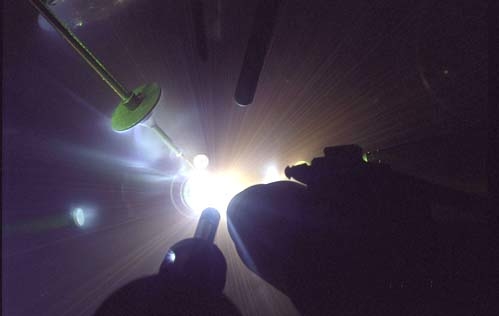Diamond experiments yield hard results
 (Download Image)
Photo credit: Eugene Kowaluk, LLE Time-integrated photograph of an OMEGA laser shot to measure high-pressure diamond strength. The diamond target is at the center, surrounded by various diagnostics. The bright white light is ablated plasma, and radial yellow lines are tracks of hot target fragments very late in time.
(Download Image)
Photo credit: Eugene Kowaluk, LLE Time-integrated photograph of an OMEGA laser shot to measure high-pressure diamond strength. The diamond target is at the center, surrounded by various diagnostics. The bright white light is ablated plasma, and radial yellow lines are tracks of hot target fragments very late in time.
Most people know that diamond is one of the hardest solids on Earth, so strong that it can easily cut through glass and steel.
Surprisingly, very little is known about the strength of diamond at extreme conditions. But new research by Laboratory scientists shows that diamond becomes even stronger during rapid compression.
Using the Janus laser at LLNL and the OMEGA laser at the University of Rochester, Livermore scientists and Rochester and UC Berkeley colleagues showed that when shock waves are applied to diamond with powerful lasers, it can support almost a million times atmospheric pressure before being crushed.
The research has implications for the technological uses of diamond.
"It could also provide insights into the ancient history of natural diamonds found on Earth and in meteorites, where shock waves caused by impact are common," said Stewart McWilliams, lead author of a paper appearing in the upcoming edition of the journal, Physical Review B.
McWilliams conducted the experiments as a graduate student at UC Berkeley while on a Student Employee Graduate Research Fellowship (SEGRF) at LLNL.
In the recent research, the team measured the behavior of natural diamond crystals under shock-wave compression between 1 million and 10 million atmospheres of pressure, and the diamonds were crushed and melted in just a nanosecond (one billionth of a second).
"What we found is that diamond exhibits considerable strength right up to the point it melts," McWilliams said.
"We reached some surprising conclusions about the strength of diamond," said LLNL co-author Jon Eggert. "This type of research informs us about the interiors of the gas giants as well our own planet."
Earlier research conducted by Livermore scientists revealed that diamond melts at around 6 million atmospheres of pressure and 14,000 degrees Fahrenheit. Their experiments mimicked conditions on the icy gas giant planets (Uranus and Neptune) where, according to their research, icebergs of diamond could float on a sea of liquid carbon.
Other Livermore authors include Damien Hicks, David Bradley, Peter Celliers and Gilbert Collins.
Contact
Anne M. Stark[email protected]
Tags
Jupiter Laser FacilityPhysical and Life Sciences
Featured Articles







